The wind blasted the exposed pontoon, upending tackle boxes and sending casts every which way. Our baits sat on the edge of a weed bed and though the wind had caused a bow in both lines, we could see it pull straight from time to time as fish tested the baits.
The weather eased for a moment, the rod bent double and I was on. After a short fight, a large redfin came to the surface and as it did, my friend cast a bait behind the fish. In an instant, another fish took the bait. While I was unhooking my reddie, my friend pulled out a large golden perch – winter impoundment fishing at its best!
It is action like this that taught me to take short, targeted sessions in winter seriously. I had been reading a lot about European fishing competitions and they connect to large redfin in winter so I thought I might try some of these techniques. They worked and with some honing, the natives started to turn up, too.
What I found most fascinating about these sessions were the sheer numbers of fish we caught, as well as the size of some of the specimens. So now I’m going to suggest it’s a myth that natives bite only in the warmer months and that freshwater fishing in winter can sometimes, dare I say it, be better than in summer.
Short sessions require planning and preparation. To start with, it is important to identify a suitable spot.
I find pontoons near significant weed beds or rock walls best because these areas need to be berleyed and the bait tends to hang around these areas for longer.
I don’t fish a spot in winter until I have visited at least twice and berleyed thoroughly. I berley with bread on the first day and follow the next with a mix of chopped scrub worms, bread, yabby claws, corn and Ultra-Bite.
I remember Rob Paxevanos a few years ago went down to his local jetty and berleyed without fishing. He said that over-fishing with baits on hooks can spook the fish and that by using berley, the fish become more inclined to bite again because they hadn’t felt a hook for a while. This seems to work.
Remember: Short sessions are 1-2 hours but this preparation means that you won’t have to worry about preparing when you do fish the spot. You can just get stuck in.
Natives and redfin at this time of year can be very finicky feeders – fussy doesn’t begin to cover it, so fish light. I use a 5’9” Daiwa Procaster with a Regal 1000 reel and 2lb mono with a 4lb trace and No 4 baitholder hooks on a running sinker rig.
You will hook a lot more fish on lighter gear. That can make big fish a bit tricky, especially when trying to land them, but I find it to be a lot more fun.
Towards the end of winter I often bring a baitcaster with 10lb braid and 20lb trace because I have found these sessions can produce cod in late August. It is even possible to watch them chase the redfin right in to shore, so it is worthwhile packing a heavier rod just in case.
The bigger redfin bite better in the colder months so you have to be prepared for some real monsters up to 1.2kg.
I recommend taking a variety of baits and a couple of different types of lures.
I always bring a dozen or so scrub worms, the same number of yabbies, some grubs, corn and half a loaf of bread.
Big baits work better at this time of year so it is important to pack the hook with as much bait as possible.
I use large bunches of scrub worms and two yabbies on the same hook. In this way, the scrub worms will knot themselves around each other and unknot again, causing a stir that even the most lethargic winter redfin won’t resist.
Two yabbies on the same hook works in a similar fashion; they often kick in the opposite direction, which usually gets the fish to at least investigate.
I have also started using bread and corn with good results. At first I thought I would catch only carp but the largest redfin of the winter thus far took a large piece of bread balled around the hook. We have gone on to catch dozens on bread and this bait is increasingly becoming our go-to option for bigger fish.
Unfortunately, carp do turn up for a feed of bread but because they are interspersed with captures of large redfin, it doesn’t matter too much.
Until recently, I never used lures during these short sessions because I had not had any success and the baits were always getting attention. But in recent weeks I have been flicking some plastics around for good results.
Now, I always pack a couple of black and gold and Gary Glitter 60mm Squidgies.
Focus around early afternoon – the windier the better, I find. I think the wind tends to move the bait around the water column and it also means that the berley will spread out across the weed or other structure.
Start with worms and cast flush against the weed or pontoon. Wait a few minutes and if you haven’t got a bite, start slowly retrieving your bait, giving it an occasional twitch. Try to keep the bait as hard up against the structure as possible.
Alternatively, cast in, wait a few moments and then slowly move the rod tip from side to side; pause and then repeat. This can often wake a yellowbelly or at the very least get the redfin keen.
If the worms aren’t getting any attention, switch to a double yabby and repeat the technique. Make sure the yabbies are small and that you have removed the claws, making them less threatening towards the fish. If neither of these baits works, switch to bread and wait.
Once you do hook a fish, make sure you don’t rush it in. Keep the fish swimming around for a while. I find the first fish, when kept in the water around the snag, will get others on the bite so by keeping it there and casting another bait near it you could get another hook up or two.
After the hook-up, if you are fishing with some mates try throwing a plastic behind the hooked fish and twitching it up towards the surface; this technique has resulted in some big golden perch and also works on small cod.
The natives tend to follow the redfin up to the bait but are not always inclined to take it and will instead hit the redfin. By having a lure that mimics a redfin in the water, you are maximising your chances of connecting with a native.
Fishing for natives in winter isn’t something I took seriously until recently and I would have said that golden perch and Murray cod just aren’t on the agenda from June to August.
However, with meticulous preparation, berleying and short, targeted sessions, you really can get on to some amazing redfin and golden perch captures in the colder months. If you are lucky, a cod might turn up, too. Twenty-fish sessions have proved to me that winter fishing can be as productive as any summer session – if you are willing to brave the weather!
Reads: 2648
Releasing a winter golden perch. Prepare well and make your sessions short and you can succeed.

The cod are usually small, but a cod is a cod.

Late winter days can be quite pleasant when the fish are biting and the wind isn’t blowing.
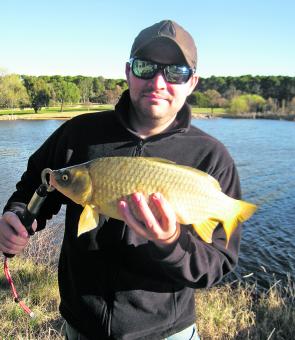
Big carp can turn up at times and when the action is slow they are almost welcome.
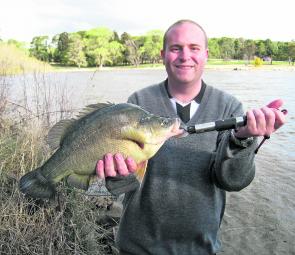
Stu Mitchell with a big winter yella caught while drifting a yabby through the berley trail.
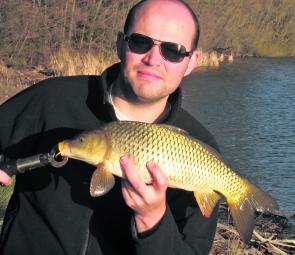
Smaller carp can be pests when the action heats up. They love getting among the redfin and yellowbelly in search of a feed.
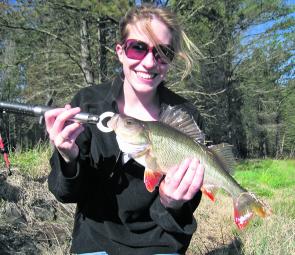
Sam Fuz with a kilo redfin. Feeding frenzies are the key to fishing in winter. During this session 20 good fish were caught in hour.
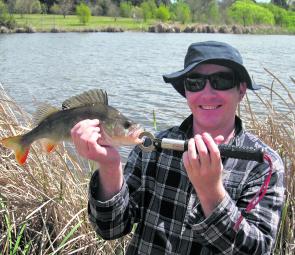
A late winter redfin that took a scrub worm drifted past a weed bed.

Big winter redfin are a lot of fun on light gear. The author with a good fish.

Spinnerbaits work well on winter cod.




